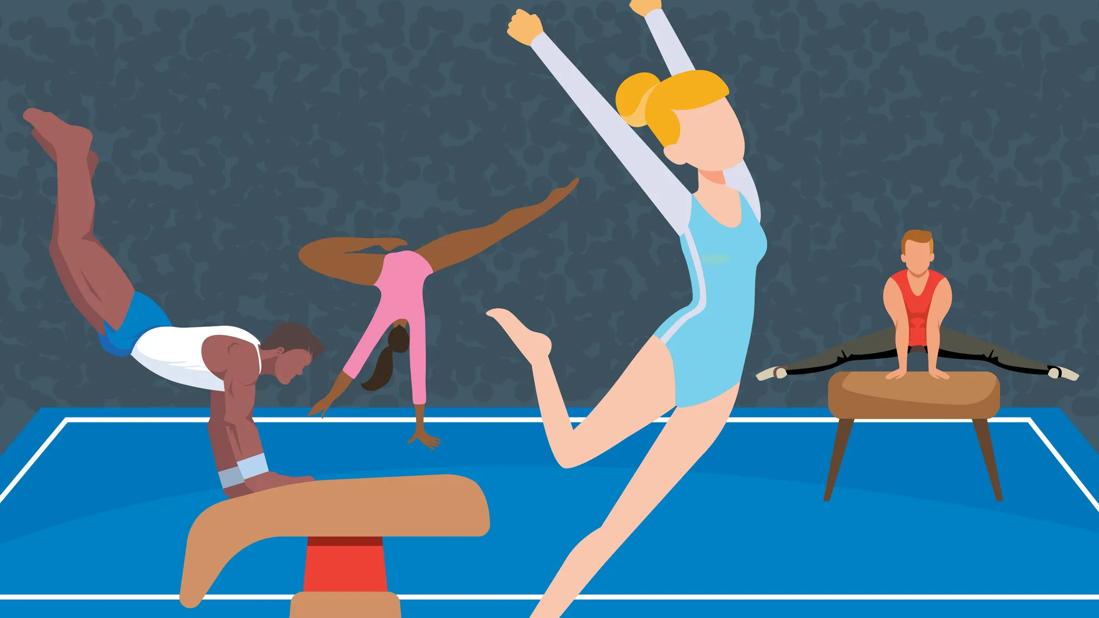The mental block is a brain-body disconnect that causes gymnasts to lose their sense of space on flips

Gymnasts invest thousands of training hours perfecting gravity-defying routines. Day after day at practice, they build up muscle memory to guide their bodies through flips and twists. It takes years to refine these skills.
Advertisement
Cleveland Clinic is a non-profit academic medical center. Advertising on our site helps support our mission. We do not endorse non-Cleveland Clinic products or services. Policy
But all that work can be undone in an instant with a case of “the twisties,” a mental block that creates a dangerous disconnect between mind and body while gymnasts are airborne.
At its worst, the twisties can ground even the world’s most high-flying gymnasts.
So, what causes this performance condition and — perhaps more importantly — can it be reversed? Let’s take a closer look at the twisties with the help of sports psychologist Matthew Sacco, PhD.
Achieving in gymnastics requires mastery of movement through repetition. As gymnasts learn skills, they build neural pathways in their brains that instruct muscles to act and respond in a certain way.
This brain-body connection is what allows a gymnast to rotate their body multiple times in a split-second during events like the vault. It becomes a trained instinct, with no on-the-spot thinking needed.
But the twisties interrupt that autonomous process.
“All of a sudden, there’s a disconnect in the feedback loop,” explains Dr. Sacco. “The brain and body are no longer communicating efficiently, and that causes a gymnast to lose sense of where their body is in space while they’re in the air.”
Gymnasts have described the feeling as a mental “stutter step” with a loss of body control mid-flight. At that critical moment, they can’t make the necessary adjustments to safely land on their feet.
Advertisement
It’s a phenomenon that has sidelined the world’s best gymnasts given the risk of injury. “It’s a terrifying feeling when the twisties hit,” he adds.
The twisties are most often connected to gymnastics but can affect competitors in any sport where proprioception — or your body’s ability to sense movement and position — is essential. Other examples include diving and ski jumping.
There’s no single answer as to what triggers the twisties. “It can be a little bit of everything and anything,” says Dr. Sacco.
Common factors include:
The twisties aren’t a one-size-fits-all condition. There are levels to it.
“It can occur in degrees,” clarifies Dr. Sacco. “It’s not unusual for a gymnast to have a moment or two when they feel the twisties coming on, but then they find a way to work it out and they’re out of it.”
Other times, the uncomfortable feeling can escalate until a gymnast can’t safely compete.
The good news about the twisties? Gymnasts generally overcome the mental block and the fear it can bring using tactics like these:
Advertisement
If the twisties deeply take root and shut a gymnast down, talking to a mental health professional may also be an avenue to return to competition.
The relationship between mental health and sports is complicated, acknowledges Dr. Sacco. It’s difficult for many to understand the powerful effect of an invisible condition (like the twisties) on an athlete.
“If you look at a gymnast with the twisties, they look fine,” he says. “There’s no cast that says something is broken. Because of that, there will always be some people who just don’t buy into it being a thing.”
But today, far more discussion takes place about the twisties and other performance-altering mental health issues in sports. High-profile athletes sharing their struggles have helped increase understanding.
“It’s great when these issues get out there and people can talk about it,” says Dr Sacco. “There’s comfort in knowing you’re not alone in dealing with something. It makes it much easier to ask for and get the help you might need.”
Advertisement
Learn more about our editorial process.
Advertisement

To avoid swimmer’s eye, wear goggles, use eye drops and flush out your eyes with fresh, clean water when irritated

Keep kids safe while they swim by staying vigilant and setting up a safe pool environment

Having a well-rounded, healthy nutrition plan is just as important as staying consistent with your exercise routine

Whether you’re cycling consistently or occasionally, it’s important to have safety essentials like a helmet, shirts with sleeves, eye protection and more

Concussion protocol describes the steps needed to test for concussion and return to play — timelines vary

A more open conversation on athletes and their mental health needs is overdue

You can reduce your risk by not swallowing water, and showering before and after swimming

Wait until they’re at least 6 months old before your little one takes their first dunk

Babies can get congested easily, but you can calm their cough by keeping them hydrated, using nasal drops and running a humidifier

Weight loss may cause loose, sagging skin and muscle loss to your rear

Several conditions, like vitiligo and fungal infection, can cause a loss of pigmentation, leading to white spots or patches on your skin